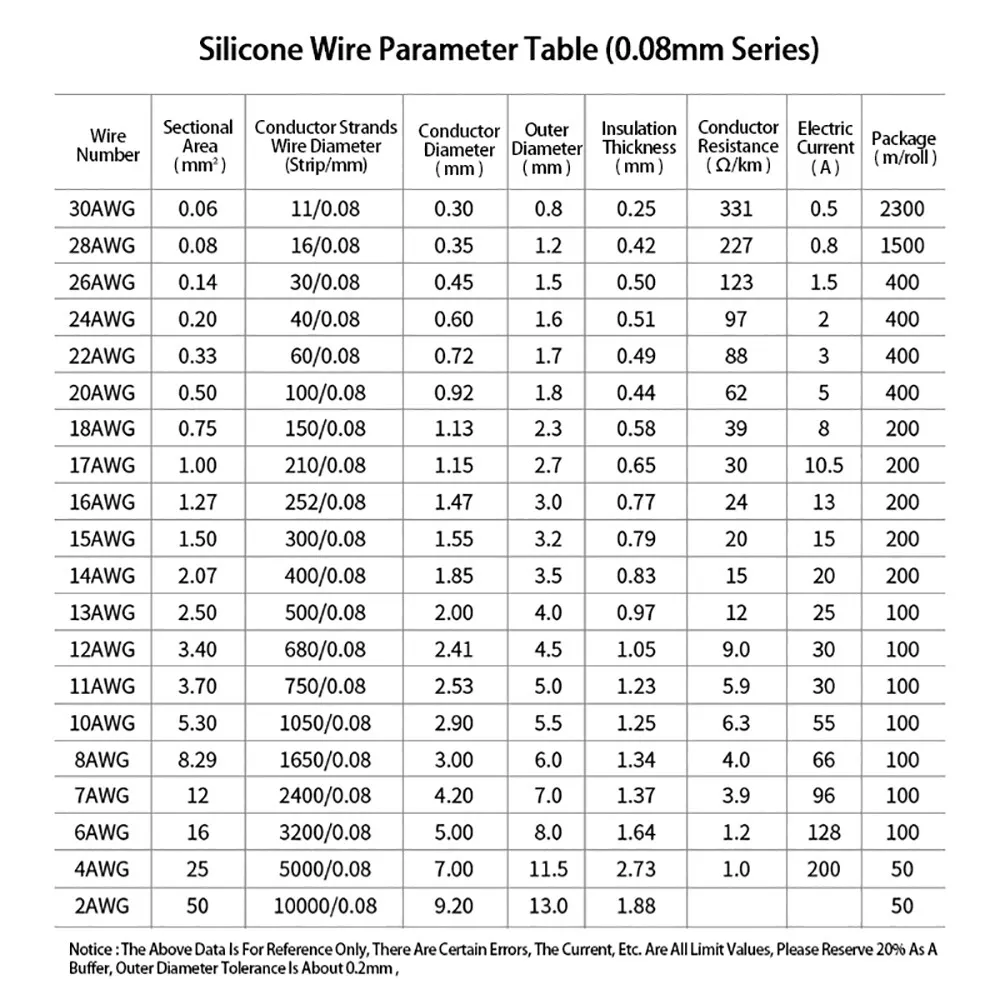1. Product core introduction
HomeDIYer presents the 2 - 30AWG Soft Silicone Stranded Copper Automotive Equipment Cable, available in blue, green and white. Specially crafted for automotive electrical applications. With its excellent quality and reliable performance, it can provide you with stable and continuous power transmission, whether it is for upgrading automotive electronic equipment or routine maintenance work.
2. The main characteristics of the product
Wide AWG Coverage: A wide range of gauges from 2AWG to 30AWG is available to meet the diverse current carrying needs of different electrical components in automobiles. For example, a high-power car starter motor may require a thick wire gauge of 2AWG - 4AWG to ensure a stable supply of strong current, while some precision electronic sensors inside the car may only require a thin wire gauge of 28AWG - 30AWG to meet their weak signal transmission and low-power power supply requirements, allowing the user to accurately select the type according to the specific application scenarios, optimizing the configuration of the electrical system to ensure efficient operation of the equipment. The advantages of soft silicone material are outstanding.
Outstanding advantages of soft silicone material: The use of soft silicone as the insulating layer gives the cable excellent flexibility, which facilitates flexible wiring in the complex interior space of the car, easily bypassing all kinds of narrow passages, corners and obstacles, greatly reducing the difficulty of installation and improving work efficiency. At the same time, the silicone also has excellent high-temperature resistance, can work stably in high-temperature environments such as automotive engine compartments, effectively preventing insulation aging, deformation or damage caused by high temperatures, to ensure that the cable's long-term and reliable electrical insulation performance, extend its service life, reduce maintenance frequency and cost.
Stranded copper conductor with excellent performance: the conductor consists of multiple strands of stranded copper wire, this structure not only further enhances the flexibility of the cable, making it easier to bend and operate, and compared to solid copper conductor, stranded wire can better adapt to the vibration of the car during travelling and frequent changes in mechanical stress, reducing the risk of conductor fracture, ensuring the stability and continuity of power transmission. At the same time, copper, as an excellent conductive material with low resistance characteristics, can efficiently transmit current, reduce the loss of electrical energy in the transmission process, and improve the overall performance of the automotive electrical system.
Three optional colours for easy identification and differentiation: blue, green, white three-colour design for automotive electrical wiring provides a convenient means of identification, the user can be based on their own habits or specific wiring rules, the different colours of the cable is assigned to the different functions of the electrical line, such as blue for the positive power line, green for the signal transmission line, white for the negative pole or grounding line and so on. Such clear and unambiguous labelling helps to quickly and accurately connect the various electrical components during installation, and at the same time, in subsequent maintenance and troubleshooting, it can quickly locate the problematic lines, save time and effort, and improve work efficiency and accuracy.
3. Product use scene
Car audio system upgrading and transformation: in the car audio modification project, it is used to connect amplifiers, hosts, speakers and various audio processors and other equipment. Its soft silicone material and stranded wire structure make the wiring easier and more flexible, and can easily adapt to the narrow space inside the car, avoiding damage to the vehicle interior due to wiring difficulties. At the same time, different AWG specifications can meet the power requirements of different power components in the audio system, ensuring that the audio equipment can obtain a stable and pure power supply, which significantly improves the sound quality effect and brings more shocking and clearer music enjoyment to the drivers and passengers.
Enhancement and optimisation of automotive lighting system: Whether it is upgrading the headlights, adding fog lights, daytime running lights, or creating personalised interior ambient lighting, this cable can play an important role. It transmits power stably and reliably to ensure the normal operation of the lighting system, and also maintains good insulation under high temperature environments to prevent electrical failures caused by high temperatures. In addition, by using its colour marking function, it can clearly distinguish the power and control lines of different lighting fixtures, which is convenient for installation and debugging, enhance the functionality and aesthetics of the automotive lighting system, and enhance the safety and comfort of night driving.
Automotive electronic equipment retrofitting and integration: With the continuous development of automotive technology, more and more car owners choose to install various electronic equipment for their vehicles, such as car recorder, car navigation, reverse camera system, electronic dog, car refrigerator, mobile phone charger and so on. The normal operation of these devices depends on a stable power supply and signal transmission, and the cable's wide AWG specifications and excellent performance can meet the electrical connection needs of these devices. Its flexibility and high-temperature resistance enable it to adapt to various working conditions in the process of automobile driving, ensuring that electronic equipment can work stably under different environmental conditions, providing more convenience and safety for drivers, and enhancing the overall level of automobile intelligence and user experience.
Automotive engine compartment electrical connection and maintenance: the engine compartment is the core area of the automotive electrical system, concentrating the generator, starter motor, battery, various sensors, controllers and a large number of electrical lines. The cable's soft silicone insulation can effectively resist the high temperature, oil, chemical corrosion and strong electromagnetic interference generated by the engine, ensuring the stability and reliability of the electrical connection in harsh environments. Its stranded copper conductor can carry the large current impact when the engine starts, and stably transmit the signals required by various sensors and controllers, providing a strong guarantee for the normal operation of the engine. In the electrical maintenance and troubleshooting work in the engine compartment, its clear colour marking is also convenient for technicians to quickly and accurately identify and overhaul the wiring, improving maintenance efficiency and reducing maintenance costs.
4. Product use instructions
Preparation before installation:
Comprehensively check the appearance of the cable and look carefully for defects such as breakage, scratches, flaking insulation, loose strands or oxidised copper wires. Pay special attention to check whether the sealing at both ends of the cable is intact, if there is any problem, stop using it immediately and contact the supplier for replacement to ensure that the quality of the cable used is intact and meets safety standards.
According to the specific needs of the vehicle's electrical equipment and in conjunction with the actual wiring plan, accurately determine the AWG specifications and colours of the cables required, and prepare the appropriate installation tools such as wire strippers, crimpers, electrical knives, insulating tape, heat-shrinkable tubing, soldering tools (if applicable), and so on. Ensure the precision and applicability of the tools, and keep them clean and sharp to avoid unnecessary damage to the cables during operation, affecting their electrical performance and service life.
Wiring and Connections:
When wiring inside the vehicle, be sure to follow the wiring specifications and safety principles of the automotive electrical system, avoid direct contact between the cable and sharp objects, high-temperature parts (e.g., engine exhaust, radiator, etc.), moving parts (e.g., fan blades, belt pulleys, etc.), and prevent the cable from being scratched, scalded, abraded, or damaged as a result of being subjected to mechanical stress, so as to ensure that the internal structure of the cable is not damaged and that it maintains its good electrical performance .
When connecting cables to electrical equipment, first use wire strippers to carefully strip the insulation from the end of the cable, then insert the copper wire into the connecting terminal and firmly press it using crimping pliers to ensure a tight, reliable and good contact to avoid loose and false connections that could lead to electrical failures. If welding connection is involved, suitable solder and welding process should be used to ensure that the solder joints are firm, smooth, no false welding, and after the completion of the welding of the solder joints for proper insulation to prevent short-circuit and leakage accidents.
In the wiring process, make full use of the cable's colour marking function, according to the pre-planned wiring scheme, the different colours of the cable neatly and orderly arranged in the interior of the car, and do a good job of the corresponding line marking and fixing, to ensure that the line is clear, easy to identify and manage, to avoid confusion and cross-tangled situation. For longer cable lines, if they need to be spliced or extended, reliable quality terminals or connectors should be used and connected in strict accordance with their operating instructions, to ensure that the electrical properties and mechanical strength of the connection meet the requirements, and at the same time do a good job of insulation and protective measures to prevent moisture, dust and other impurities from entering the connection parts to affect the electrical properties.
Precautions for use:
Use this cable in strict accordance with the rated voltage and current parameters specified in the product specification, and strictly prohibit exceeding its permissible maximum value, otherwise it may cause electrical safety accidents, such as short-circuit, fire, burnt electrical equipment, etc., which will seriously endanger the safety of vehicles and personnel. When connecting multiple electrical devices, be sure to accurately calculate the total power and current to ensure that the selected cable can safely and stably carry the load and avoid various problems caused by overloading.
Regularly check the connecting parts and overall appearance of the cables, especially after a long period of vehicle travelling, bumpy roads or harsh environmental conditions. Check whether there is loose, oxidation, corrosion, breakage, etc. If any abnormality is found, it should be repaired or replaced in a timely manner to ensure that the cable is always in a good working condition, and to protect the normal operation of the automotive electrical system and electrical safety. At the same time, in the car maintenance, repair or other operations involving the electrical system, special attention should be paid to the protection of the cable to avoid unnecessary damage caused by human negligence or improper operation.
Try to avoid the cable coming into contact with water, oil, chemical solvents and other liquids. Although the soft silicone insulation layer of this cable has a certain degree of corrosion resistance, prolonged or heavy contact with these liquids may still have an adverse effect on its insulating properties. For example, after the vehicle is travelling in rainy days, passing through waterlogged roads or carrying out car washing operations, it is necessary to check the cable in time to see if it has been exposed to moisture, water or contaminated by chemical substances. If stains or moisture are found on the surface of the cable, it should be gently wiped clean with a clean cloth and dried if necessary to ensure that the insulating properties are not affected.



















